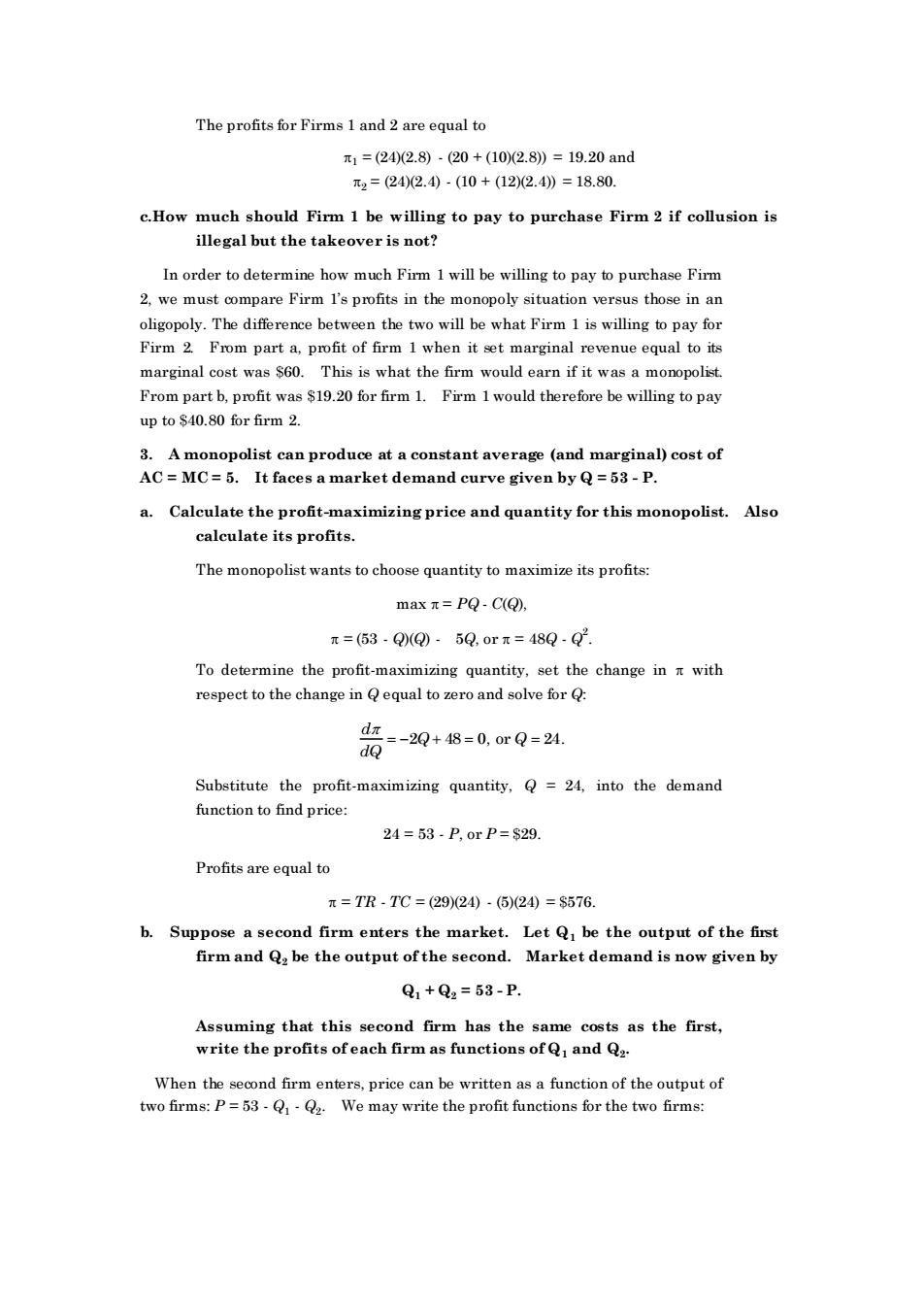正在加载图片...

The profits for Firms 1 and 2 are equal to 元1=(242.8)-20+(102.8)=19.20and 元2=2402.4)-(10+(122.4》=18.80. c.How much should Firm 1 be willing to pay to purchase Firm 2 if collusion is illegal but the takeover is not? In order to determine how much Firm I will be willing to pay to purchase Firm 2.we must compare Firm I's profits in the monopoly situation versus those in an oligopoly.The difference between the two will be what Firm 1 is willing to pay for Firm 2 From part a,profit of firm 1 when it set marginal revenue equal to its marginl what the firm would arn if it was a From part b.profit was $19.20 for firm 1.Firm 1 would therefore be willing to pay up to $40.80 for firm 2. 3.A monopolist can produce at a constant average(and marginal)cost of AC=MC=5.It faces a market demand curve given by Q=53-P. a.Calculate the profit-maximizing price and quantity for this monopolist.Also calculate its profits. The monopolist wants to choose quantity to maximize its profits: max元=PQCQ =(53.Q(Q).5Q.or =480.Q. Todetermine the profit-maximizing quantity,set the change inwith respect to the change in equal toero and =-2Q+48=0,orQ=24 Substitute the profit-maximizing quantity,Q=24,into the demand function to find price: 24=53-P,0rP=$29. Profits are equal to 元=TR.TC=(29)24到·(6)24④=$576. b.Suppose a second firm enters the market.Let Q be the output of the first firm and Q,be the output of the second.Market demand is now given by Q1+Q2=53-P. Assur that this second firm has the osts as the first write the profits ofea When tho irmenters,price can be writt two firms:P=may write the profit functions for the two firms: The profits for Firms 1 and 2 are equal to 1 = (24)(2.8) - (20 + (10)(2.8)) = 19.20 and 2 = (24)(2.4) - (10 + (12)(2.4)) = 18.80. c.How much should Firm 1 be willing to pay to purchase Firm 2 if collusion is illegal but the takeover is not? In order to determine how much Firm 1 will be willing to pay to purchase Firm 2, we must compare Firm 1’s profits in the monopoly situation versus those in an oligopoly. The difference between the two will be what Firm 1 is willing to pay for Firm 2. From part a, profit of firm 1 when it set marginal revenue equal to its marginal cost was $60. This is what the firm would earn if it was a monopolist. From part b, profit was $19.20 for firm 1. Firm 1 would therefore be willing to pay up to $40.80 for firm 2. 3. A monopolist can produce at a constant average (and marginal) cost of AC = MC = 5. It faces a market demand curve given by Q = 53 - P. a. Calculate the profit-maximizing price and quantity for this monopolist. Also calculate its profits. The monopolist wants to choose quantity to maximize its profits: max = PQ - C(Q), = (53 - Q)(Q) - 5Q, or = 48Q - Q 2 . To determine the profit-maximizing quantity, set the change in with respect to the change in Q equal to zero and solve for Q: d dQ Q Q = −2 + 48 = 0, or = 24. Substitute the profit-maximizing quantity, Q = 24, into the demand function to find price: 24 = 53 - P, or P = $29. Profits are equal to = TR - TC = (29)(24) - (5)(24) = $576. b. Suppose a second firm enters the market. Let Q1 be the output of the first firm and Q2 be the output of the second. Market demand is now given by Q1 + Q2 = 53 - P. Assuming that this second firm has the same costs as the first, write the profits of each firm as functions of Q1 and Q2 . When the second firm enters, price can be written as a function of the output of two firms: P = 53 - Q1 - Q2 . We may write the profit functions for the two firms: